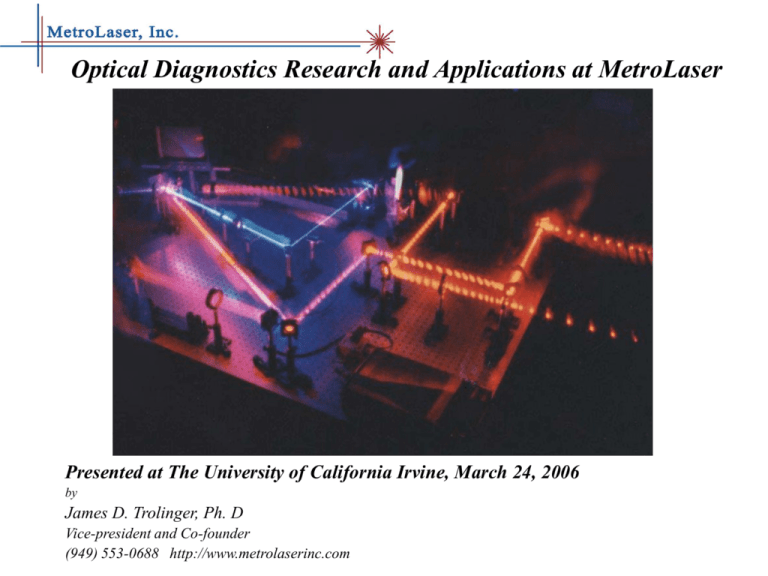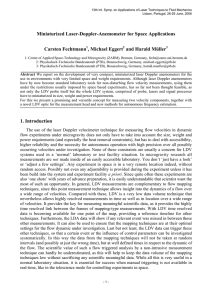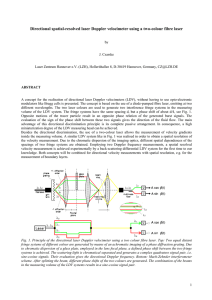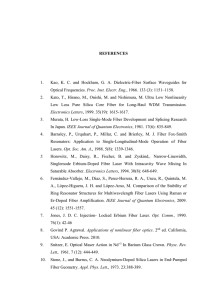MetroLaser Real-Time Blade Profilometer
advertisement

Optical Diagnostics Research and Applications at MetroLaser Presented at The University of California Irvine, March 24, 2006 by James D. Trolinger, Ph. D Vice-president and Co-founder (949) 553-0688 http://www.metrolaserinc.com History and Achievements • • • • • • • June 1988: Founded by Drs. Cecil Hess and Jim Trolinger. 1994: U. S. SBA Distinguished Award of Excellence. 1995: U. S. SBA National Prime Contractor of the Year. 2000: Spun off 4DVision Technologies Inc. 2004: AIAA Aerodynamics Measurement Technology Award 2006: Ongoing collaborations with 14 universities 2006: 30 employees, 15 Ph. D’s. • Thirteen electro-optical laboratories in Irvine CA. • Providing State of the Art Optical diagnostic instruments, services, & research to government and industry. MetroLaser/UCI Collaborations • MetroLaser has had joint contracts with UCI continuously for nearly 18 years. • Over 30 different programs, subcontracts in excess of $2M. • MetroLaser 4 fulltime employees and 10 interns from UCI. • Currently have 3 active joint proposals Summary 1. Laser Doppler Vibrometry 2. Aerodynamic and Aero optic Measurement Technology 3. Optical Sensors for NDT, monitoring, detection, and discrimination 4. Tracking and Ranging for Space Situation Awareness Technologies for Vibration Analysis • Electronic Digital Holography (PhaseCam) • Laser Doppler Vibrometry – Single beam – Multiple beam – Matrix • Applications – – – – – Non Destructive Testing Modal analysis Machinery health monitoring Remote microphone Land mine detection MetroLaser Vibrometer Impact Testing of a Concrete Column in the Civil Engr. Lab at UC Irvine Typical Frequency Response of a Column Increasing damage Reduction of Natural Frequency With Increasing Damage Automotive Experiments Use VibroMet 500 to measure the engine vibration as a function of engine speed Automotive Experiments Variation of Peak Frequency and Velocity with Engine Speed Landmine Detection Scanning or Multipoint Laser vibrometer Loudspeaker 50-300 Hz Ground Surface Land mine MetroLaser LDV Cart Array Lane 13, VS2.2., Depth = 1” Broadband Excitation, 80-300 Hz Multibeam LDV Correlation of LDV Defect Data With Ultrasound Image of a F-15 Vertical Stabilizer MultiBeam Full Field Application Dual Array Configuration Custom Matrix Configuration 10” Blade - 4940 Hz Electronic (Digital) Holography • Holographic data stored on CCD array. • Digital wavefront reconstruction Phase shifting interferometry (hologram plane). Diffraction theory (propagate to image). • Interferograms are computed. • Amenable to fiber optical implementation. Commercial MetroLaser wavefront sensor Laser Object Beam Transmitting Lens Receiving Lens 3D Plot of Turbine Blade Vibration Mode Discovering Lincoln in the Cent Profilometry Detail of US penny shows 1 mm profiling resolution Flow Visualization Holography Analyzing flow fields for density, velocity, temperature Dynamic optical Pathlength Measurements in real time Complete experiment Wavefront Data-Baseline L/D=9 Schematic of aero-optic model. Aero-Optic Effects Boundary layer turbulence & shock wave Window Cooling Computer Model of System Model Model masks used to simulate aero-optic effects Stress induced widow aberrations Imaging system model Aberrated Wavefront Shock Turbulence Window Image Plane AOTS Simulated Aero-Optical Effects Planar Doppler Velocimetry System for use in the AEDC 16 Foot Transonic Wind Tunnel Facility Laser Reference Frequency System Proposed PDV installation in 16T AF03-251 (AC10) Fiber Optic Microsensors for HighResponse Gas Total Temperature Measurement Air Force Requirements High response measurement of total temperature distortion at up to 48 locations around turbine inlet. Minimum flow blockage from sensor array Robust against flow borne particulates Probe replacement with minimum down-time 8000 R/s T= 300 R Task 2: Design of fiber optic microsensor Construction fiber cladding / 125mm fiber core / 10mm metallic mirror 0.01mm FP etalon 1-2mm ZnSe / Si/SiC 0 metallic mirror 0.1mm Characteristics Intrinsic solid state FP sensor Environmentally isolated 125mm high bandwidth response minimum flow disruption 2mm high density array deployment scattered light metal surface detectors scanner scanner feature specular reflection Light Scattering Fatigue Detection Notched Fatigue Sample 13 P = 720 N N = 9796 N = 14096 Nf = 43736 Active Laser Tracking System Concept CPU: System control & Data processing 3D state vector Velocity Maneuvering Vibration Visible & IR Radiation Seed Laser Laser driver and controller Coherent Coherent Detection Radiation Non-coherent Radiation Control and Data Processing Platform Beam directing & Propagation through telescope platform atmosphere Target tracking, sensing & imaging Laser Tracking System (Operational Principles) CPU 0.7O M2 Multifunctional detector-array provides information on: • Delay time distance • Doppler shift velocity V • Spatial/angular coordinates NLM P2 IR P1 Laser & Visible M1 FPI design and assembly Desired Imaging FPI specification Tuning range: t > 5 nm Bandpass width: p < 0.01 nm or p/ < 10-5 Acceptance angle: p ~ 1 ~ 0.017 rad Working aperture: 1.0 inch Transmittance T0 40 – 50 % Background rejection > 20 dB Central-wavelength: ~700 nm TDLAS System Layout for H2O z y x Fiber flame Beam launch ~3 cm 2-into-1 Fiber combiner w1 = 1343 nm Tunable Diode lasers InGaAs Detector w2 = 1392 nm Laser current controller Waveform generator Computer for signal processing Swirl Burner at UCI Combustion Lab Results Comparison (T1) TDLAS temperature and CO2 chemiluminescence: 1350.0 1330.0 1310.0 1290.0 1270.0 1250.0 1230.0 1210.0 1190.0 1170.0 1150.0 6500.0 6000.0 5500.0 5000.0 CO2* run avg T1 run avg (K) FS = -70% 100% Load T1run CO2 run 4500.0 0.0 10.0 20.0 30.0 40.0 50.0 4000.0 60.0 EA (%) EA = excess air: air beyond stoichiometric EPA SBIR Opportunities-coming • • • • • • • • • • • • • • • • • • Improving the Great Lakes Control of Air Pollution Monitoring and Remote Sensing Green Buildings Mining and Mine Waste Management Lead Paint Detection and Removal Agriculture and Rural Community Improvement Management of Animal Feeding Operations Drinking Water Treatment and Monitoring Pollution Indicators for Beaches and Recreational Waters Water and Wastewater Management Innovation in Manufacturing for Environmental Protection Nanotechnology Engine and Vehicle Emissions Reduction Solid and Hazardous Waste Homeland Security. Website- www.epa.gov/ncer/sbir/ Homeland Security SBIR • Opened10 March – 10 April, 2006 Full Proposals 10 April, 2006 Deadline for • • AEROSOL COLLECTION INTO LOW ANALYSIS VOLUMES (ACLAV) RELIABLE PEROXIDE-BASED EXPLOSIVES DETECTION WITH LOW FALSE ALARM RATE ENHANCED EXPLOSIVE SAMPLE COLLECTION AND/OR PRECONCENTRATION SYSTEMS SIGNAL PROCESSING FOR A SOUTHERN BORDER SURVEILLANCE SYSTEM HUMAN DETECTOR FOR CARGO SHIPPING CONTAINERS INSTANTANEOUS REMOTE SENSING DATA RECEIVING AND PROCESSING FOR EMERGENCY RESPONSE NETWORK-BASED BOUNDARY CONTROLLERS BOTNET DETECTION AND MITIGATION MANAGING MULTI-MEDIA SURVEILLANCE INFORMATION NETWORKS • • • • • • • Thank you for your attention You can download this presentation from our website: www.metrolaserinc.com











